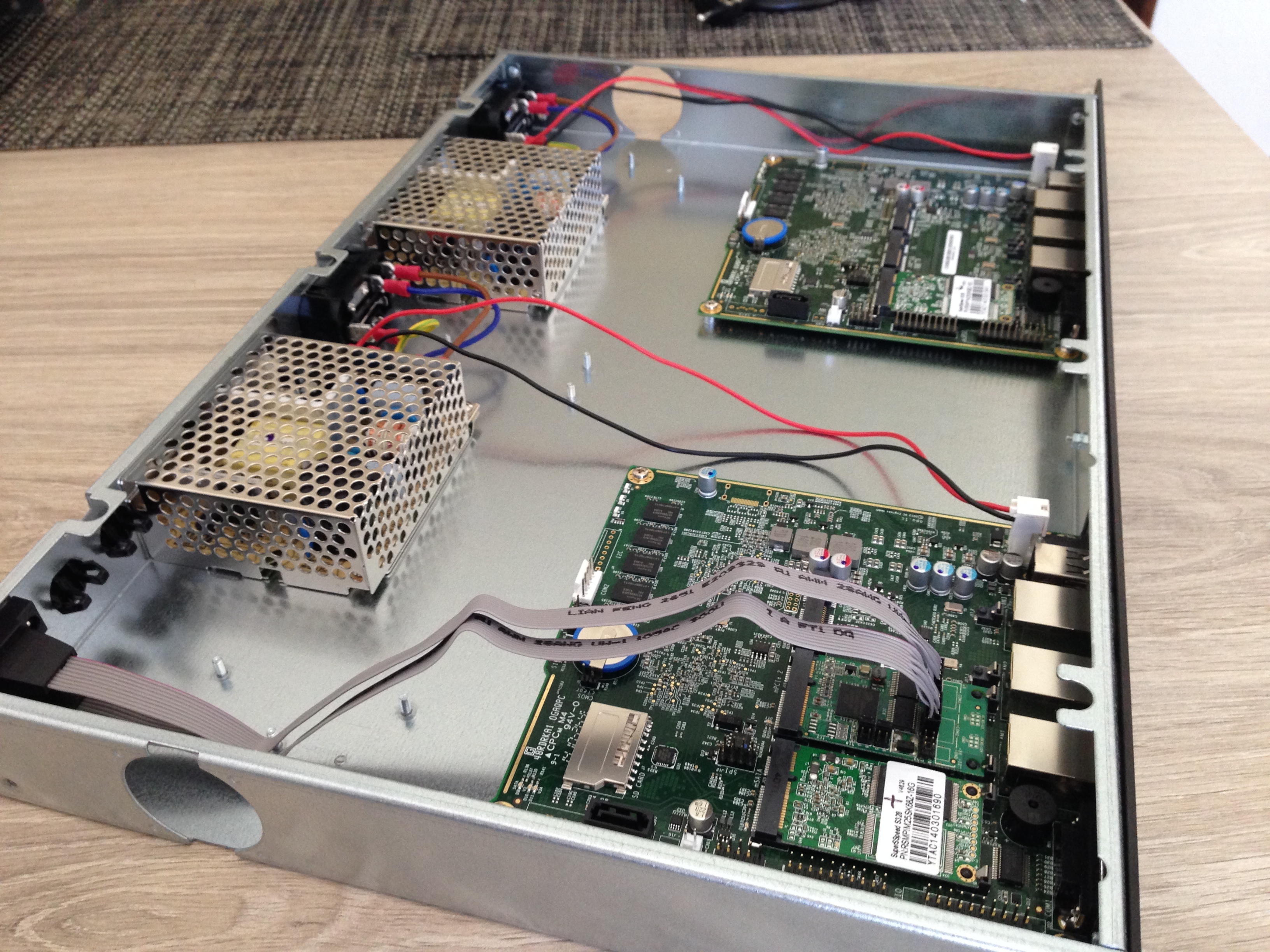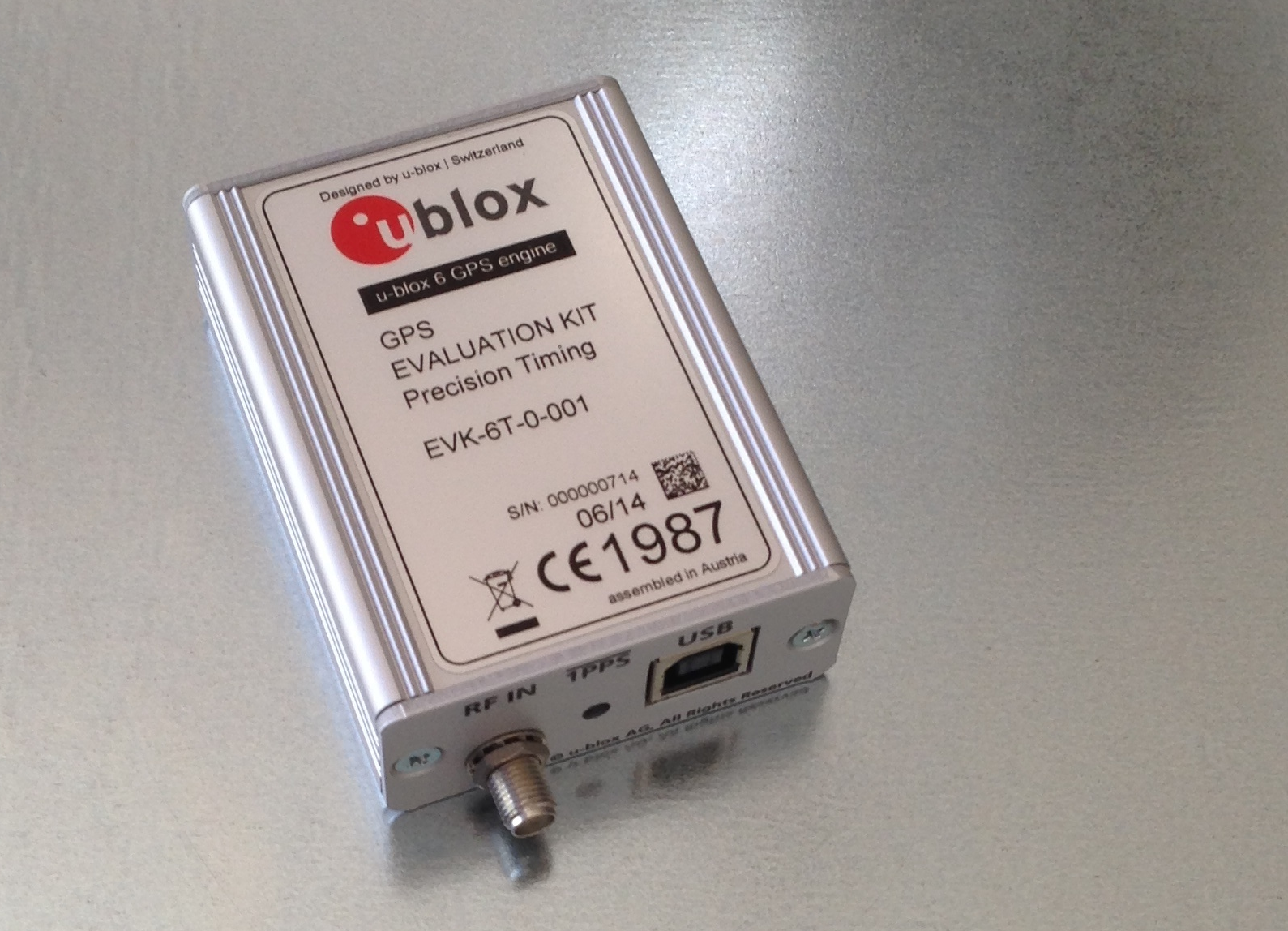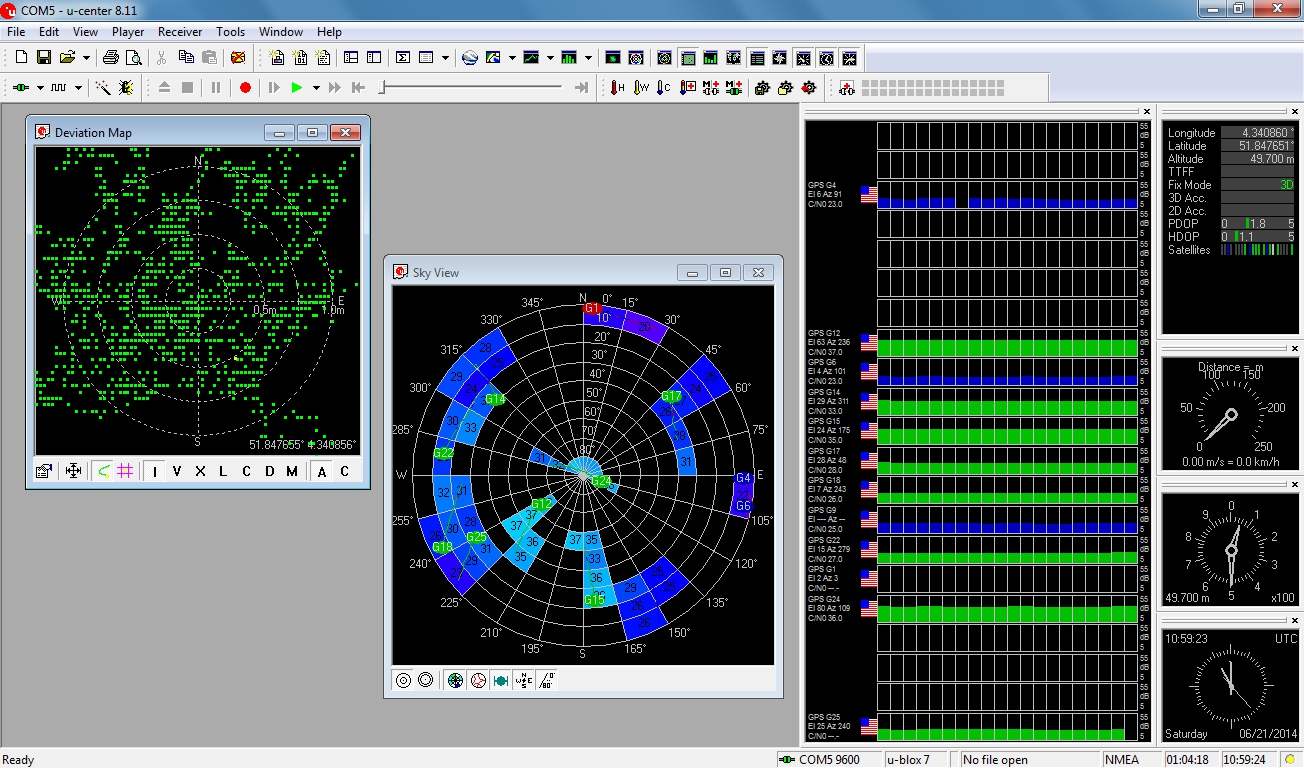pc_engines_apu_ublox_6_timing_gps_ntp
Table of Contents
PC Engines APU / u-blox 6 Timing receiver / NTP
Prerequisites:
- PC Engines APU
- Additional serial port(s)
- u-blox 6 timing receiver (evaluation kit)
Documentation:
Install and configure OS
- Install Voyage linux using PXE (network) or USB.
- After installation, log in as root (password voyage) and remount read/write.
# remountrw
- Create non root user.
useradd username passwd username
- Change hostname /etc/hosts /etc/hostname, configure network.
- Change apt mirrors in /etc/apt/…
- Install prerquisites.
apt-get install dialog setserial
- Update.
apt-get update apt-get upgrade
- Configure time zone.
dpkg-reconfigure tzdata
- Configure locale.
apt-get install locales dpkg-reconfigure locales
- Edit Voyage Linux config to enable writing to ntp drift file. Edit /etc/default/voyage-util
VOYAGE_SYNC_DIRS="var/lib/ntp"
Install and configure gpsd
- Install gpsd.
apt-get install gpsd gpsd-clients
- Reconfigure gpsd, add the -n option:
dpkg-reconfigure gpsd # GPS device /dev/gps0 # Add -n option
Install and configure NTPd
- We need to compile NTP to enable ATOM PPS support.
(apt-get remove ntp ntp-doc) cd /root apt-get install dpkg-dev dialog devscripts fakeroot pps-tools apt-get source ntp && apt-get build-dep ntp cd ntp-4.2.6.p5+dfsg debuild -us -uc cd .. dpkg --install ntp_4.2.6.p5+dfsg-2+deb7u1_amd64.deb dpkg --install ntp-doc_4.2.6.p5+dfsg-2+deb7u1_all.deb
- Configure NTPd to run at the highest priority. Edit /etc/default/ntp
NTPD_OPTS='-g -N'
- Create PPS device and set low_latency. Add udev rules. Create /etc/udev/rules.d/gps.rules.
KERNEL=="ttyS2", SYMLINK+="gps0" KERNEL=="ttyS2", RUN+="/bin/setserial -v /dev/%k low_latency" KERNEL=="ttyS2", RUN+="/usr/sbin/ldattach pps /dev/%k"
- Configure /etc/ntp/conf.
# Allow more distance between GPS (USB) and Serial PPS. # Stratum level 12 when no ref source available tos mindist 0.100 orphan 12 driftfile /var/lib/ntp/ntp.drift leapfile /var/lib/ntp/leap-seconds statsdir /var/log/ntpstats/ statistics loopstats peerstats clockstats filegen loopstats file loopstats type day enable filegen peerstats file peerstats type day enable filegen clockstats file clockstats type day enable # Local servers server ntp1.polaire.nl # ATOM PPS (/dev/pps0) server 127.127.22.0 minpoll 4 maxpoll 4 fudge 127.127.22.0 refid PPS # GPS (USB /dev/ttyACM0) server 127.127.28.0 minpoll 4 maxpoll 4 prefer fudge 127.127.28.0 refid GPSd fudge 127.127.28.0 time1 0.063 # By default, exchange time with everybody, but don't allow configuration. restrict -4 default limited kod notrap nomodify nopeer noquery restrict -6 default limited kod notrap nomodify nopeer noquery # Local users may interrogate the ntp server more closely. restrict 127.0.0.1 restrict ::1
- Remove /var/lib/ntp/ntp.conf.dhcp
- Disable automatic update of ntp package. Remember to update it yourself in case of security updates!
sudo apt-mark hold ntp ntp-doc
- Reboot and check results.
Leap second file
Automatic download of new leap second file.
- Install lftp.
apt-get install lftp
- Create leap second download script: /usr/local/bin/get_leap.sh
- Change executable mode
chmod +x /usr/local/bin/get_leap.sh
- Download new file weekly. Create /etc/cron.weekly/leapsecond
#!/bin/bash /usr/local/bin/get_leap.sh
- Change executable mode
chmod +x /etc/cron.weekly/leapsecond
Verify
- Make sure gpsd and ntpd start at boot. If not, enable it.
update-rc.d ntp enable update-rc.d gpsd enable
- Test PPS reception.
# ppswatch /dev/pps0 trying PPS source "/dev/pps0" found PPS source "/dev/pps0" timestamp: 1403289214, sequence: 11, offset: 81613988 timestamp: 1403289214, sequence: 11, offset: 81613988 timestamp: 1403289215, sequence: 12, offset: 81607583 timestamp: 1403289215, sequence: 12, offset: 81607583 timestamp: 1403289216, sequence: 13, offset: 81609303 timestamp: 1403289216, sequence: 13, offset: 81609303 timestamp: 1403289217, sequence: 14, offset: 81601958 ^C
- Check ntpq status. The 'o' means, PPS is working.
$ ntpq -p remote refid st t when poll reach delay offset jitter ============================================================================== ntp1.polaire.nl .PZF. 1 u 47 64 1 0.270 12.367 0.001 ntp2.polaire.nl 95.97.208.29 2 u 48 64 1 0.293 12.720 0.001 ntp3.home.polai .DCF. 1 u 47 64 1 0.300 13.941 0.001 oPPS(0) .PPS. 0 l - 16 7 0.000 12.355 0.102 *SHM(0) .GPSd. 0 l 2 16 7 0.000 1.188 1.431 # After a while... remote refid st t when poll reach delay offset jitter ============================================================================== +ntp1.polaire.nl .PZF. 1 u 56 64 377 0.292 -0.099 0.075 -ntp2.polaire.nl 95.97.208.29 2 u 50 64 377 0.289 0.638 0.086 +ntp3.home.polai .DCF. 1 u 41 64 377 0.237 1.656 0.048 oPPS(0) .PPS. 0 l 15 16 377 0.000 0.027 0.003 *SHM(0) .GPSd. 0 l 16 16 377 0.000 -8.657 2.708 - Show connected clients:
ntpdc -c monlist
- Verify leap variables:
ntpq -c "rv 0" associd=0 status=0118 leap_none, sync_pps, 1 event, no_sys_peer, version="ntpd 4.2.6p5@1.2349-o Tue Jan 6 09:09:39 UTC 2015 (1)", processor="x86_64", system="Linux/3.10.11-voyage", leap=00, stratum=1, precision=-22, rootdelay=0.000, rootdisp=85.497, refid=PPS, reftime=d8562b21.98df89e1 Tue, Jan 6 2015 10:36:33.597, clock=d8562b2d.36477b48 Tue, Jan 6 2015 10:36:45.212, peer=27238, tc=4, mintc=3, offset=0.000, frequency=0.000, sys_jitter=8.116, clk_jitter=65.587, clk_wander=0.000, leapsec=201207010000, expire=201506280000
Configure, firmware update ublox 6 module
The module is attached to an embedded device and you cannot run Windows on the APU system board. The following directions will let you pass through the serial device to a Windows computer over the network. Then you will be able to run the u-center GNSS evaluation software for Windows.
APU config
- Install socat.
apt-get install socat
- Connect serial to TCP port.
socat file:/dev/ttyACM0,raw,echo=0 tcp-l:3006,fork&
Windows config
I'm using Windows 7 in this example.
- The com0com.sys is a test-signed kernel-mode driver that will not load by default. NOTE: Enabling test signing will impair computer security. To enable test signing, enter command:
bcdedit.exe -set TESTSIGNING ON
- Reboot
- Download and install com0com and com2tcp http://sourceforge.net/projects/com0com/files/?source=navbar
- Launch setup to determine virtual com port pair. In my case it's COM5 ⇔ COM6
- Start cmd.exe, run:
com2tcp.exe --ignore-dsr \\.\COM6 1.2.3.4 3006
- Download and install u-center http://www.u-blox.com/en/evaluation-software/u-center.html
- Run u-center, go to Receiver → Port → COM5
- Receiver → Generation → u-blox 6
Screenshot
Recommended settings for timing applications
- SBAS → Subsystem: Disabled.
- TMODE2 → Fixed location. As a rule of thumb the position should be known with an accuracy of better than 1 m for a timing accuracy in the order of nanoseconds. If an accuracy is required only in the order of microseconds, a position accuracy of roughly 300 m is sufficient. If the position is known, the receiver can provide an accurate time solution by tracking only one satellite. For an unknown position, the receiver needs a minimum of four satellites to calculate a position fix and to solve for a timing solution. This is known as survey-in and can be chosen using the UBX-CFG-TMODE2 message. It is recommended to use survey-in only for non-moving platform applications. For optimal performance a known fixed position of the antenna should be used.
- NAV5 → Dynamic Model: Stationary
- TP5 → Active, 1Hz, 0, Lock to GNSS, Other setting, 1Hz, 100000us, Align Pulse to TOW, 0-UTC time, clear invert pulse.
pc_engines_apu_ublox_6_timing_gps_ntp.txt · Last modified: 2021/10/09 15:14 by 127.0.0.1



